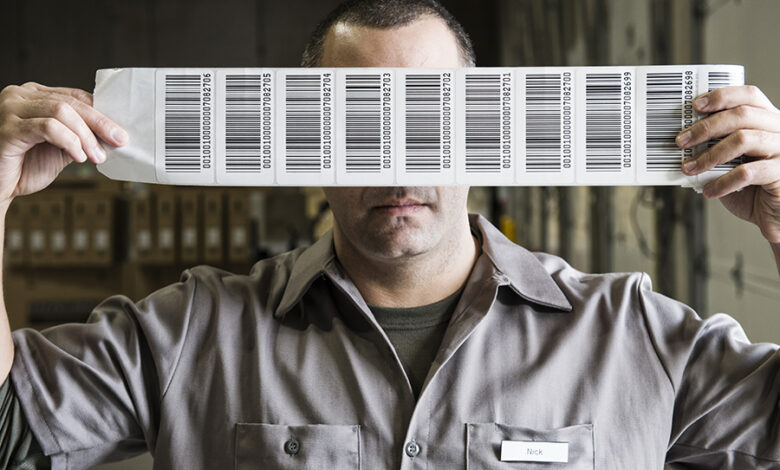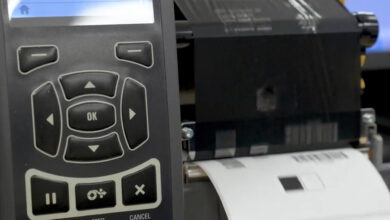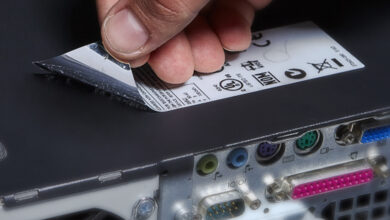Thermal Transfer Labels

What Are Thermal Transfer Labels?
Just take a quick look around you. Everywhere you look there are products of some kind and all products need one thing, labels. Preferably, labels that won’t fade away too quickly.
The best way to produce on-demand high-quality labels is the thermal transfer printing method. This article will explain all you need to know about thermal transfer labels.
How Does Thermal Transfer Work?
 Since we’re talking about a printing method, there’s a printer involved, though not quite like the printer you have at home or at the office.
Since we’re talking about a printing method, there’s a printer involved, though not quite like the printer you have at home or at the office.
Thermal transfer printing uses the heat generated by the printing head to transfer an image, most often a barcode, on a label. So, we have a printer and a label. However, there’s a third element involved, the ribbon.
To put it simply, the ribbon goes between the print head and the label itself. The print head heats up when a label passes in front of it and that heat is applied to the ribbon. At that moment, the desired image is printed on the label.
What Is a Thermal Transfer Ribbon?
 The ribbon is essential in the thermal transfer printing process. It is a thin film that has a black coating on one side. This black coating is usually made of wax or resin. During the printing process, you place the ribbon with the coated side facing the printing material.
The ribbon is essential in the thermal transfer printing process. It is a thin film that has a black coating on one side. This black coating is usually made of wax or resin. During the printing process, you place the ribbon with the coated side facing the printing material.
The heat generated by the print head transfers this black coating in such a way as to create the desired image. That barcode you see on a label is nothing but wax or some resin formulation transferred to that little piece of paper through thermal transfer.
What’s the Difference Between Thermal Transfer and Thermal Printing?
Both printing methods can be used to produce labels quickly and in a large quantity. However, with direct thermal printing, there is no ribbon involved. Instead, this method relies on the properties of the label material itself, a special type of paper called thermal label.
The principle is the same. The print head heats up and that heat activates compounds in the printing paper to produce an image.
Why Are Thermal Transfer Labels Better Than Direct Thermal Labels?
 On thermal transfer labels, the printed image is of better quality. The image is sharper, which is a big plus when it comes to labels that include fine print. If you’ve ever had problems at the supermarket with the shop assistant struggling to read the barcode on an item, that’s probably because the image on the label was of poor quality.
On thermal transfer labels, the printed image is of better quality. The image is sharper, which is a big plus when it comes to labels that include fine print. If you’ve ever had problems at the supermarket with the shop assistant struggling to read the barcode on an item, that’s probably because the image on the label was of poor quality.
Secondly, labels produced via thermal transfer printing are more resistant. The wax transferred to the paper will last longer and it will withstand even harsh environmental elements, such as excessive humidity or exposure to harsh chemicals. Also, using this method, the labels come out dry and can be used immediately.
Finally, it’s not just the image or the barcode that will last for longer, but the paper itself. That’s because the thermal transfer printing method is gentler on the printing material.
Print heads are available in various resolution options, anywhere between 203dpi and 600 dpi.
Now, DPI stands for dot per inch. Each print head has several dots. During the printing process, each dot will heat up for a brief time and once it’s done melting its part of the wax, it will immediately cool off, minimizing damage to the printing paper.
Closing Thoughts
Thermal transfer printing is the most reliable way to create labels. Thermal transfer labels are made by using heat to melt the wax or resin coating on a ribbon, to make an image appear on the printing paper. Thermal transfer labels are of a better quality than direct printing labels and will last longer.
Additional Resources
- Zebra Printers – Video Explaining Thermal Transfer Printers by Zebra
- SATO Industrial Thermal Printers – SATO’s Industrial barcode printers are the hallmark of printing products for harsh environments and applications


